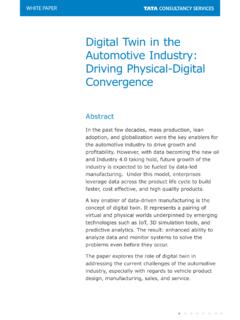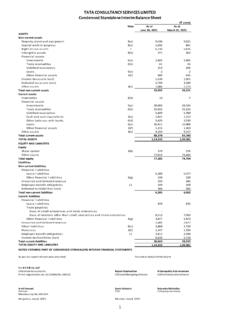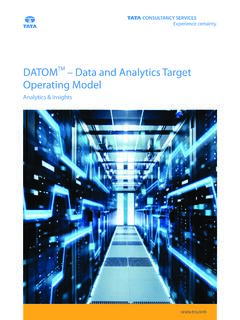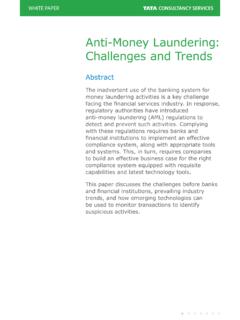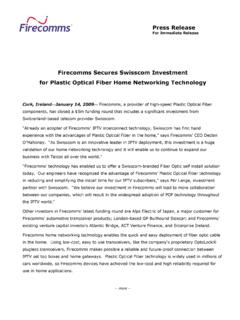Transcription of RPA for Telcos: The Next Wave of BPM Evolution
1 WHITE PAPERRPA for telcos : The next Wave of BPM Evolution As various disruptive digital technologies continue to upend the traditional business models and trigger unprecedented changes in customer behavior, the telecommunication industry must fundamentally reimagine its operations. A swift modernization of existing business processes and cost-prohibitive systems is vital for wireless carriers to capitalize on the emerging opportunities to grow revenues in the digital the years, several inefficiencies have crept into processes across the sector. For instance, the typical operations landscape of many communications services providers (CSPs) continues to be weighed down by disparate systems, siloed processes, and highly labor-intensive activities that hinder business agility.
2 This, in turn, adversely impacts telcos ability to effectively respond to the rapidly evolving customer demands, and diminishes their ability to compete effectively with new-age cross-industry players. Unless the industry streamlines its operations first, any economies of scale and transformation benefits that may result from digitization initiatives will at best be , telcos need to evaluate their existing IT infrastructure and application systems in view of the dynamic business priorities. Advanced technologies such as automation, cognitive computing, and artificial intelligence (AI) will help wireless carriers effectively transform their core operations, and realize business outcomes faster for higher return on investment (ROI). From an operational standpoint, this would translate into telcos manual, time-consuming, and expensive processes being replaced with automated software solutions that are more reliable and be fair to CSPs, they embraced process automation more than a decade ago.
3 Many telcos have since launched several business process management (BPM) projects to eliminate manual intervention in different functions spanning their operations support systems (OSS) and business support systems (BSS). Be it for optimizing the workflows underpinning network inventory and configuration and service provisioning, or automating processes concerning revenue and order management, operators have aggressively adopted does then the new wave of process automation, enabled by the likes of AI and machine learning, fit in? Does this technology stack known as robotic process automation (RPA) require a standalone deployment, or can it be integrated with the BPM implementation in a non-intrusive way? And, what tangible business benefits can telcos accrue from these investments?
4 The RPA promise Traditionally, companies based their business strategy on structured data from enterprise applications and relational databases. Given Big Data s Variety challenge, relational databases that store structured information are ill-suited to storing, analyzing, and processing Big data-driven planning has been recognized as the best practice in business, Big Data is changing some age-old notions of management. It is often confused with data value proposition of RPA is simple: to automate manual, logically-designed processes that are repetitive and time-consuming. Telecom operators could leverage RPA to automate the bulk of their employees routine tasks spanning both the front office and back office, freeing them up to perform high-value activities.
5 Consequently, CSPs will be able to substantially bring down the total cost of ownership (TCO) for OSS and BSS systems, and reduce the time-to-market and boost customer , telcos can roll out RPA at a fraction of the time and costs it would otherwise take them to execute such workflows. The technology can typically be installed within WHITE PAPER weeks, without placing much demand on IT services. RPA can help the industry become more agile and cost-efficient on multiple fronts; for instance, processing a huge volume of transactions with scopeHowever, considering RPA is essentially based on the idea of streamlining predictable workflows, some industry participants are wondering if it is truly different from BPM, or can serve as a view RPA as a logical extension of the existing BPM implementation.
6 While BPM ensures robust process stability for optimized business performance, RPA offers turnkey, non-complex solutions that can be harnessed to realize productivity improvements and cost BPM is more strategic in nature, RPA is largely tactical. RPA can, however, only cover repetitive tasks, and is not effective for solving workflow-related challenges across enterprise systems and can deploy RPA across a wide range of processes that were earlier outside the scope of BPM, owing to the latter s financial implications and change management effects. RPA, given its relatively smaller footprint, entails a far lower capital expenditure. It can be used for different, unrelated processes such as non-core activities of accounting, HR reporting, and administrative tasks without requiring additional differentiating aspect of RPA is that it works at the user-interface level, thereby not necessitating any major changes in the core IT systems, and minimizing security.
7 Additionally, RPA s underlying design characterized by a visual data flow model enables business users to hit the ground running without having to depend too much on organizations IT departments. RPA can be scaled up or down depending on dynamic business , RPA is compatible with a host of enterprise systems and process automation exercises including BPM, which means that the investments you have already made with regard to enterprise IT won t go a waste; rather you d be able to realize the ROI from all of those PAPERE merging use casesHow exactly can the telecom industry use RPA to reimagine its operations for rapid business transformation? To begin with, CSPs could leverage the technology to automate back-end activities such as data entry and validation, and reconciliations, that involve turnaround times (TATs) running into days.
8 Executing such tasks within minutes will allow telcos to plug substantial revenue leakages, and enhance customer satisfaction, through prompt resolution of should also look at deploying RPA for streamlining their customer support processes, including the ones related to ticket management, first call resolutions, and customer call handling. Diligent tracking of key performance indicators (KPIs) around BSS operations can eventually help CSPs identify areas of inefficiencies, and lower the cost of running service , intelligent automation capabilities embedded within RPA can enable marketing and sales to engage in targeted cross-selling and up-selling, through assisted calls, next -best action, and other such but not the least, other core processes such as order decommissioning and capacity management can also be improved appreciably by using business benefitsThe potential benefits RPA can deliver are significant.
9 According to an Everest Group study1 published in October 2015, it can facilitate cost reduction in the range of 35% to 65% for onshore process operations, and up to 30% for offshore delivery. Through faster, efficient execution of manual, rules-based tasks, these software robots could drive noteworthy reductions in cycle times across different areas of operations, a PwC report2 released in 2016 PAPERA part from orchestrating tangible gains in relation to TCO and business agility, RPA could help telcos ensure enhanced service delivery through better process quality, governance, continuity, and the last two decades, the telecom industry has been one of the most enthusiastic adopters of IT, riding the various waves of technological disruption for ensuring better customer connect.
10 As robotics, machine learning, and AI begin to fundamentally transform the way companies provision their services in an on-demand economy, telcos too will have to revisit some of their long-held operating principles. With the stabilization of new technology, telcos are keen on adopting RPA. RPA and BPM are playing a pivotal role in such adoption and transformation, and are being leveraged in both medium and large cognitive intelligence programs involving ICR, NLP, text mining, and machine [1] Everest Group, Seizing the Robotic Process Automation (RPA) Market Opportunity, October 28, 2015, accessed on June 12, 2017, [2] PwC, Organize your future with robotic process automation, 2016, accessed June 12, 2017, PAPERA bout The AuthorNirmalya ShomeNirmalya Shome is a Domain Consultant with TCS Communications, Media, and Technology business unit.


